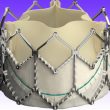Courtesy of Dr. Agustín Vecchia. As TAVR is expanded to lower risk patients, complications become more relevant. As regards stroke, the PARTNER 2 and SURTAVI one year outcomes are 8.0% and 8.2% respectively. The mechanisms behind this complication have not yet been clarified and, therefore, neither have guideline recommendations in this regard (as we can tell<a href="https://solaci.org/en/2017/08/02/dual-antiplatelet-in-tavr-is-single-better/" title="Read more" >...</a>
Lotus vs Sapien 3, different mechanisms with similar results
The new generation devices for transfemoral transcatheter aortic valve replacement have been optimized to improve valve position and reduce residual aortic regurgitation. This study compared 30 day, 12 month and 24 month outcomes of the repositionable, Lotus valve, with controlled mechanical expansion, and the balloon-expandable valve Edwards Sapien 3. Primary end point was all cause mortality<a href="https://solaci.org/en/2017/07/26/lotus-vs-sapien-3-different-mechanisms-with-similar-results/" title="Read more" >...</a>
Increasing operator experience improves TAVR outcomes
The introduction of transcatheter aortic valve replacement (TAVR) into clinical practice in the United States has been a tightly controlled process aimed at optimizing patient outcomes and minimizing the learning curve. Many strategies have been used to reach a rational dispersion for this new technology, including choosing sites with enough volume, and adequate operator training<a href="https://solaci.org/en/2017/07/26/increasing-operator-experience-improves-tavr-outcomes/" title="Read more" >...</a>
SENTINEL study: cerebral protection during TAVR
Neurological complications during and after transcatheter aortic valve replacement (TAVR) are probably the only event whose incidence has not been reduced by new valve designs (as opposed to paravalvular leak, vascular complications, or need for pacemaker implantation). Aside from the potential seriousness of this clinical event, the risk of embolism is particularly worrisome because,<a href="https://solaci.org/en/2017/06/15/sentinel-study-cerebral-protection-during-tavr/" title="Read more" >...</a>
[SURTAVI] Sub-study of neurological events: more evidence in favor of TAVR
Courtesy of SBHCI. The occurrence of a periprocedural neurological events is associated to an increased risk of death and morbidity at long term, both for transcatheter aortic valve replacement (TAVR) and for surgery. The SURTAVI study, recently presented at the ACC meeting and simultaneously published by NEJM, showed that TAVR with self-expandable CoreValve or Evolut<a href="https://solaci.org/en/2017/05/30/surtavi-sub-study-of-neurological-events-more-evidence-in-favor-of-tavr/" title="Read more" >...</a>
NOTION: TAVI with low risk at 4 year follow up
Courtesy of the SBHCI. There is little data about the use of transcatheter aortic valve replacement (TAVR) to treat patients with severe aortic stenosis at low surgical risk. Many of the questions involve long term duration of valves (over 10 years) when treating younger patients with longer life expectancy. The NOTION study aims at comparing<a href="https://solaci.org/en/2017/05/30/notion-tavi-with-low-risk-at-4-year-follow-up/" title="Read more" >...</a>
ARTE: Aspirin or Aspirin and Clopidogrel after TAVR?
Courtesy of SBHCI. This study presented at Euro PCR and simultaneously published by JACC Cardiovascular Interventions poses a question that has remained unanswered since the start of TAVR. There is little information on the optimal antithrombotic therapy after transcatheter aortic valve replacement (TAVR). In general, patients receive between 1 and 6 months of dual<a href="https://solaci.org/en/2017/05/25/arte-aspirin-or-aspirin-and-clopidogrel-after-tavr/" title="Read more" >...</a>
Further Evidence on Managing Dysfunctioning Bioprostheses with Balloon-Expandable Prostheses
Early experience with the valve-in-valve technique in the treatment of failed bioprosthetic surgical valves in transcatheter aortic valve replacement (TAVR) has yielded acceptable acute procedural results. This turned the technique into another therapeutic option, one that could even cause the reassessment of the age limit for the surgical implantation of a mechanical or bioprosthesis valve.<a href="https://solaci.org/en/2017/05/17/further-evidence-on-managing-dysfunctioning-bioprostheses-with-balloon-expandable-prostheses/" title="Read more" >...</a>
TAVR: minimalist strategy Is favorable in severe COPD
Courtesy of Dr. Carlos Fava. The presence of chronic obstructive pulmonary disease (COPD) is a criterion for which patients are ruled out for surgery and proposed as candidates for its current alternative, transcatheter aortic valve replacement (TAVR). A minimalist strategy could benefit this patient group, given the use of conscious sedation instead of general anesthesia. <a href="https://solaci.org/en/2017/05/14/tavr-minimalist-strategy-is-favorable-in-severe-copd/" title="Read more" >...</a>
Diastolic Dysfunction: Shall We Begin to Assess It?
Courtesy of Dr. Carlos Fava. The association between diastolic dysfunction (DD) and aortic insufficiency (AI) after transcatheter aortic valve replacement (TAVR) has not been studied yet, but the presence of aortic regurgitation has proved to be associated with worse outcomes. A total of 144 out of 195 patients who underwent TAVR with balloon-expandable SAPIENS or SAPIENS XT<a href="https://solaci.org/en/2017/04/19/diastolic-dysfunction-shall-we-begin-to-assess-it/" title="Read more" >...</a>









